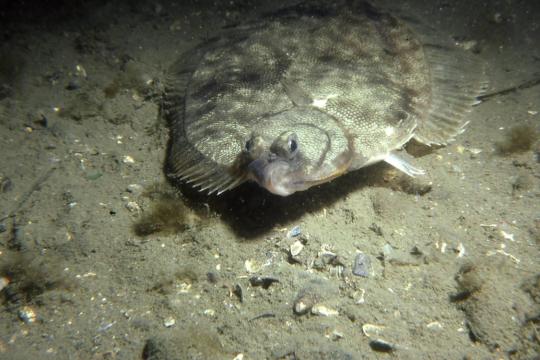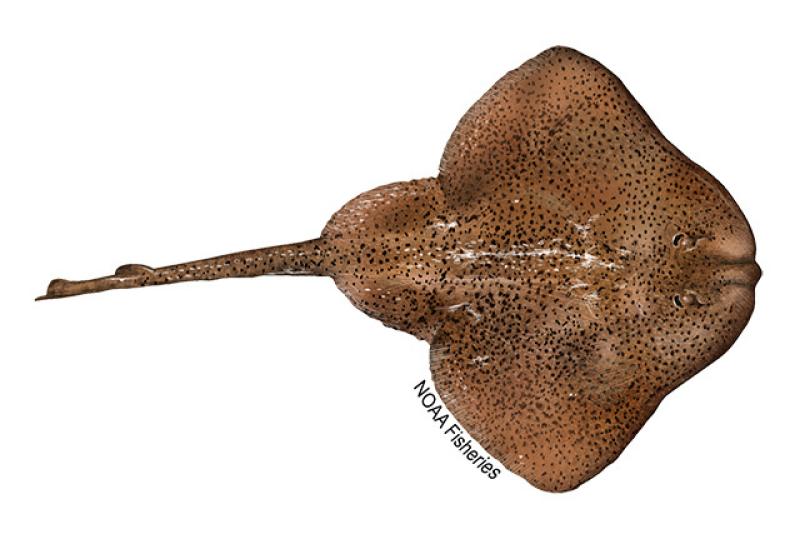About the Species
Winter skate is managed as a part of the Northeast Skate Complex along with six other skate species in the same fishery management plan. Of these species, winter skates are the primary species harvested for human consumption, for the meat in their wings. U.S. wild-caught winter skate is a smart seafood choice because it is sustainably managed and responsibly harvested under U.S. regulations.

Population
The stock is not overfished.

Fishing Rate
Not subject to overfishing.

Habitat Impact
Area closures and gear restrictions protect habitat that are affected by some kinds of trawl gear.

Bycatch
Regulations are in place to minimize bycatch.
Population Status
- According to the 2022 stock assessment, winter skate is not overfished and not subject to overfishing. Summary stock assessment information can be found on Stock SMART.
- Seven skate species, including winter skate, are managed as one northeast skate complex. There is a lack of data for this complex. New requirements to report skate landings by species should improve the data-poor nature of this complex.
- Estimates of winter skate abundance, or biomass, peaked in the mid-1980s, declined through the early 1990s, and increased again in recent years to moderately high levels.
Appearance
- Skates are a relative of sharks and rays and have a kite-like shape.
- Winter skates are light brown and covered with small dark spots.
- Small spines cover most of their back.
Biology
- Winter skates have large bodies and can grow up to 5 feet in length.
- They can live for about 20 years.
- They reproduce at a late age, when they’re approximately 11 years old and 2.5 feet long.
- Skates lay eggs year-round but have few offspring. Their eggs are enclosed in a hard leathery case called a “mermaid’s purse.” The eggs incubate for 6 to 12 months, and young skates have the adult form when they hatch.
- Skates feed on a variety of organisms such as crustaceans, mollusks, worms, squids, and fish.
Where They Live
Range
- Winter skates range from the Gulf of Saint Lawrence in Canada to Cape Hatteras, North Carolina.
Habitat
- Winter skate live on sand and gravel bottoms in the northwest Atlantic, most commonly in southern New England and on Georges Bank. They are occasionally found in the Gulf of Maine, on the Scotian Shelf, in the Gulf of Saint Lawrence, and in the Mid-Atlantic.
- Skates are not known to migrate far, but they do move with the seasons as water temperature changes. They are generally offshore during the summer and early autumn and inshore during winter and spring.
Fishery Management
- NOAA Fisheries and the New England Fishery Management Council manage the winter skate fishery.
- Managed under the Northeast Skate Complex Fishery Management Plan:
- Valid open access permit is required to catch, possess, transport, or sell skate.
- Annual catch limits for winter, little, clearnose, and rosette skates, as well as response measures if the catch limits are exceeded. Winter skates are the only species targeted for human consumption. Little skate is used as bait for lobster fisheries and clearnose and rosette skates are usually discarded.
- Fishermen are prohibited from retaining smooth (Gulf of Maine only), barndoor, and thorny skates.
- Trip limits.
- Fishermen and dealers must report their catch by species.
- Management measures in other fisheries also indirectly aid in the recovery of the overfished skate species and conserve the resource.
Harvest
- Commercial fishery:
- In 2023, commercial landings totaled 13.7 million pounds and were valued at $4 million, according to the NOAA Fisheries commercial fishing landings database.
- More than half of skate landings come from Massachusetts and Rhode Island.
- Skates are harvested in two different fisheries, one for wings for human consumption and one for lobster bait.
- In the bait fishery, vessels from southern New England target mostly little skates (more than 90 percent) and, to a much lesser extent, juvenile winter skates (less than 10 percent). Juvenile winter skates are difficult to differentiate from little skates because they look nearly identical.
- The wing fishery is labor-intensive because the wings need to be cut into fillets, but participation has grown recently due to increasing restrictions on other, more profitable groundfish species.
- In the wing fishery, mainly trawlers and gillnetters harvest winter skates when targeting other species such as groundfish, monkfish, and scallops. Fishermen keep the skates if the price is profitable.
- Gear types, habitat impacts, and bycatch:
- Most skates are caught incidentally in otter trawl fisheries targeting other more valuable species, such as groundfish, monkfish, and scallops. Otter trawls can impact habitat depending on where they are used. They can also interact with marine mammals (e.g., whales, harbor porpoises, and seals) and sea turtles. Management measures including closed areas, restrictions on gear and fishing effort, and modifying fishing gear to reduce contact with habitat help reduce these impacts and interactions.
- Skates are also caught in bottom gillnet fisheries, which have less of an impact on habitat.
- Skates are caught and discarded as bycatch in numerous fisheries, but the rate of discards has decreased in recent years as the value of skate products has increased.
Scientific Classification
- Winter skates range from the Gulf of Saint Lawrence in Canada to Cape Hatteras, North Carolina.
- Winter skate live on sand and gravel bottoms in the northwest Atlantic, most commonly in southern New England and on Georges Bank. They are occasionally found in the Gulf of Maine, on the Scotian Shelf, in the Gulf of Saint Lawrence, and in the Mid-Atlantic.
- Skates are not known to migrate far, but they do move with the seasons as water temperature changes. They are generally offshore during the summer and early autumn and inshore during winter and spring.
Fishery Management
- NOAA Fisheries and the New England Fishery Management Council manage the winter skate fishery.
- Managed under the Northeast Skate Complex Fishery Management Plan:
- Valid open access permit is required to catch, possess, transport, or sell skate.
- Annual catch limits for winter, little, clearnose, and rosette skates, as well as response measures if the catch limits are exceeded. Winter skates are the only species targeted for human consumption. Little skate is used as bait for lobster fisheries and clearnose and rosette skates are usually discarded.
- Fishermen are prohibited from retaining smooth (Gulf of Maine only), barndoor, and thorny skates.
- Trip limits.
- Fishermen and dealers must report their catch by species.
- Management measures in other fisheries also indirectly aid in the recovery of the overfished skate species and conserve the resource.
Harvest
- Commercial fishery:
- In 2023, commercial landings totaled 13.7 million pounds and were valued at $4 million, according to the NOAA Fisheries commercial fishing landings database.
- More than half of skate landings come from Massachusetts and Rhode Island.
- Skates are harvested in two different fisheries, one for wings for human consumption and one for lobster bait.
- In the bait fishery, vessels from southern New England target mostly little skates (more than 90 percent) and, to a much lesser extent, juvenile winter skates (less than 10 percent). Juvenile winter skates are difficult to differentiate from little skates because they look nearly identical.
- The wing fishery is labor-intensive because the wings need to be cut into fillets, but participation has grown recently due to increasing restrictions on other, more profitable groundfish species.
- In the wing fishery, mainly trawlers and gillnetters harvest winter skates when targeting other species such as groundfish, monkfish, and scallops. Fishermen keep the skates if the price is profitable.
- Gear types, habitat impacts, and bycatch:
- Most skates are caught incidentally in otter trawl fisheries targeting other more valuable species, such as groundfish, monkfish, and scallops. Otter trawls can impact habitat depending on where they are used. They can also interact with marine mammals (e.g., whales, harbor porpoises, and seals) and sea turtles. Management measures including closed areas, restrictions on gear and fishing effort, and modifying fishing gear to reduce contact with habitat help reduce these impacts and interactions.
- Skates are also caught in bottom gillnet fisheries, which have less of an impact on habitat.
- Skates are caught and discarded as bycatch in numerous fisheries, but the rate of discards has decreased in recent years as the value of skate products has increased.
Scientific Classification
| Kingdom | Animalia | Phylum | Chordata | Class | Chondrichthyes | Order | Rajiformes | Family | Rajidae | Genus | Leucoraja | Species | ocellata |
|---|
Last updated by NOAA Fisheries on 03/20/2025
Featured News
 Chef Tyler Hadfield’s Curried Skate Wings with Tomato-Masala Chutney
Chef Tyler Hadfield’s Curried Skate Wings with Tomato-Masala Chutney
Ring In the New Year With These Crowd-Favorite Seafood Recipes
 Winter flounder (Pseudopleuronectes americanus) in Narragansett Bay. It is a flatfish native to coastal waters of the western North Atlantic coast from Labrador to Georgia, although it is less common south of Delaware Bay. It feeds on bottom-dwelling animals. Photo: NOAA Fisheries
Winter flounder (Pseudopleuronectes americanus) in Narragansett Bay. It is a flatfish native to coastal waters of the western North Atlantic coast from Labrador to Georgia, although it is less common south of Delaware Bay. It feeds on bottom-dwelling animals. Photo: NOAA Fisheries
Predator-Prey Interaction Study Reveals More Food Does Not Always Mean More Consumption
Seafood Facts

Is Winter Skate Sustainable?
U.S. wild-caught winter skate is a smart seafood choice because it is sustainably managed and responsibly harvested under U.S. regulations.
Availability
Year-round.
Source
U.S. wild-caught from Maine to North Carolina (mainly Massachusetts and Rhode Island).
Taste
Mild flavor that is similar to scallops.
Texture
Firm and stringy.
Color
The meat is off-white, sometimes pinkish, when raw and is off-white when cooked.
Nutrition Facts
Servings: 1; Serving Weight: 100 g (3½ oz) raw; Calories: 90; Protein: 20 g; Total Fat: 1 g; Total Saturated Fatty Acids: 0 g; Carbohydrate: 0 g; Total Sugars: 0 g; Total Dietary Fiber: 0 g; Cholesterol: 0 mg; Sodium: 0 mgMore Information
Skate Recipes
Skate is an often overlooked seafood species that is suitable for a range of flavors. If you need cooking inspiration, browse these recipes for curried skate wings, casserole, and more!

Last updated by NOAA Fisheries on 03/20/2025
Seafood News
 Celebrate Culinary Arts Month with a sustainable seafood recipe for every month of the year.
Celebrate Culinary Arts Month with a sustainable seafood recipe for every month of the year.
What Your Birth Month Says About Your Next Seafood Recipe
 Fresh-caught taʻape on ice. Credit: Conservation International Hawaiʻi.
Fresh-caught taʻape on ice. Credit: Conservation International Hawaiʻi.
Reducing Waste and Feeding Communities in Hawaiʻi with a Whole Fish Approach
 Chef Tyler Hadfield’s Curried Skate Wings with Tomato-Masala Chutney
Chef Tyler Hadfield’s Curried Skate Wings with Tomato-Masala Chutney
Ring In the New Year With These Crowd-Favorite Seafood Recipes
 NOAA Fisheries, in collaboration with Blue Ocean Mariculture, is conducting a multi-year pilot study to evaluate observational methods and tools for studying Hawaiian monk seal behavior. Courtesy of Blue Ocean Mariculture
NOAA Fisheries, in collaboration with Blue Ocean Mariculture, is conducting a multi-year pilot study to evaluate observational methods and tools for studying Hawaiian monk seal behavior. Courtesy of Blue Ocean Mariculture
AI Meets Aquaculture to Study Hawaiian Monk Seal Interactions With Net Pens
Management Overview
Winter skate is managed as a part of the Northeast Skate Complex along with six other skate species in the same fishery management plan. For more information on management of this species and skates in the Greater Atlantic Region, visit the Northeast Skate Complex Group species profile or the Northeast Skate Complex Management Plan.
Last updated by NOAA Fisheries on 03/20/2025
Data & Maps
Last updated by NOAA Fisheries on 03/20/2025

